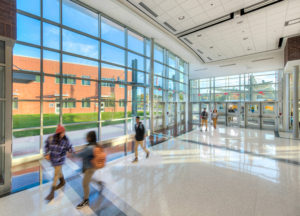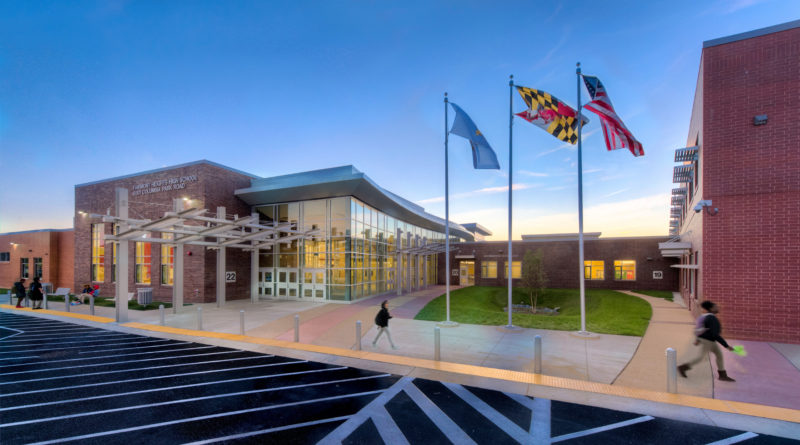Fairmont Heights High School Pursues LEED Gold
By Rachel Leber
HYATTSVILLE, Md. — Prince George’s County Public Schools completed the construction of the newly renovated Fairmont Heights High School in Hyattsville in September 2017. In addition to upgrading technological aspects of the school, the new building is pursuing LEED Gold certification for its sustainable building standards.
Grimm + Parker Architects of Calverton, Md., was selected as the architect for the project, with Grunley Construction of Rockville, Md., serving as the general contractor. The project began in April 2015 with a budget of $73.5 million.
The new 193,213-square-foot high school replaced the old facility that was built in 1950 and no longer met the educational standards of Prince George’s County, according to Jonathan Hill, senior associate at Grimm + Parker. “It was inadequate in condition and technology, so we replaced it with a 21st educational facility that is on the leading edge of technological and environmental public school construction,” said Hill.

The building is organized by grouping the major academic clusters in a classroom bar that has its frontage along major public spaces. These spaces include a 10,000-square-foot auditorium with two full-size practice courts and a main competition court with seating for 1,200. In addition, there is a 5,000-square-foot dining hall, with four serving lines, and a gymnasium. These spaces face the back of the site and provide improved layouts that maximize the potential for usage by different community groups, according to Hill.
These elements are organized on either side of a 20-foot high main corridor that has substantial clerestory and curtain wall on a north-facing frontage that connects the car and bus loops and accesses administration, media center spaces and the courtyard. Additionally, the high school’s new athletic facilities include a soccer field, baseball field and athletic support amenities.
Fairmont Heights has a number of sustainable features that are likely to earn it LEED Gold certification. An underground cistern captures rainwater and safely treats it to then recycle the water in the restrooms for toilet flushing. A geothermal well field helps to maintain a constant temperature from which to heat and cool the building, saving over 30 percent energy when compared with a baseline building. On two roofs between the classroom and public space wings of the buildings stretch fully-planted vegetated roofs, visible from corridors and classroom spaces.
In addition, pervious paving in the parking lots filter and slow down stormwater and recharge the aquifer, according to Amy Upton, principal and leader of environmental design at Grimm+Parker. In addition to the pervious paving, rain gardens and bioswales around the site, a large, pre-cast stormpod detention system underground stores and treats stormwater runoff.
Fairmont Heights is committed to integrating the sustainable features of the building and site into lessons taught at the Environmental Sciences Academy (ESA), according to Upton. “The high school is currently working with ESA to develop graphics for the interactive energy dashboard to explain what’s saving energy and conserving resources on the roof, in the walls and underground,” said Upton.
The interior learning spaces are bright, airy and daylit. Clerestory windows in the gymnasium bring in even daylight without the glare, and skylights in the media center and corridor nodes bring daylight deeper into this large high school, according to Upton. Enhanced acoustic design strategies optimize reverberation and noise reduction as well as minimizing background noise and sound transmission.

